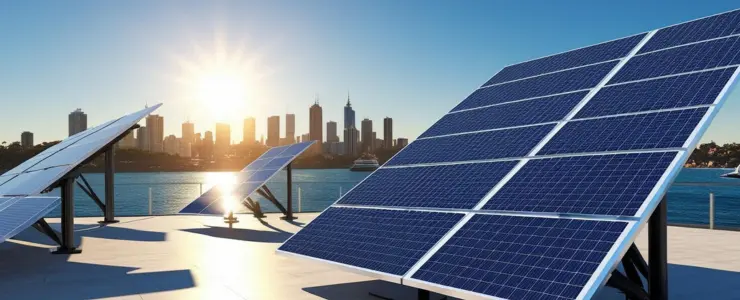How Much Does Solar Panel Cost Sydney in 2025?
As solar energy continues to rise in popularity across Australia, homeowners and businesses in Sydney are increasingly interested in understanding the cost of solar panels in Sydney in 2025. With advancements in technology, government incentives, and the growing demand for renewable energy, the price of solar systems remains an important factor for those looking to make the switch.
In this comprehensive guide, we will break down the cost of solar panels Sydney in 2025, including key price factors, government rebates, financing options, and the best solar panel packages available. Whether you are considering a small residential system or a large commercial solar setup, this guide will provide valuable insights to help you make an informed decision.
Understanding Solar Panel Costsin 2025
The solar panels cost Sydney varies depending on system size, panel efficiency, brand, and installation complexity. As of 2025, the average price for a solar system in Sydney ranges as follows:
- 6.6kW Solar System: $4,500 to $7,500 (after government rebates)
- 10kW Solar System: $7,500 to $12,500 (after rebates)
- 13.2kW Solar System: $10,000 to $15,500 (after rebates)
- 20kW Solar System: $15,000 to $25,000 (for commercial setups)
- 30kW+ Solar System: $25,000 to $50,000 (for large businesses)
The final price depends on various factors such as the type of panels used (monocrystalline vs. polycrystalline), inverter brand, battery storage, and installation complexity.
Get a quick quote!
Factors Affecting the Cost of Solar Panels in 2025
Several factors influence the cost of solar panel installation in Sydney:
1. Solar Panel Quality and Brand
Premium solar panels, such as those from SunPower, LG, and REC, offer higher efficiency and better warranties but come at a higher price. Budget-friendly options from Trina, Jinko, and Canadian Solar provide cost-effective solutions for residential installations.
2. System Size
Larger solar systems generate more power and provide greater savings on electricity bills. However, the upfront cost increases with the system size.
3. Government Rebates and Incentives
In 2025, the Australian Federal Government’s Small-scale Renewable Energy Scheme (SRES) continues to provide solar rebates based on Small-scale Technology Certificates (STCs). The rebate amount depends on system size and location, with Sydney homeowners eligible for substantial savings.
4. Installation Costs
Labor costs vary depending on the complexity of the installation. A straightforward rooftop installation on a single-story home costs less than a complex multi-story setup requiring additional mounting structures.
5. Battery Storage Integration
Adding a solar battery, such as Tesla Powerwall or Sungrow, increases the system cost but allows homeowners to store excess energy for use at night or during blackouts.
6. Financing and Payment Options
Many solar companies offer financing plans, solar leases, and Power Purchase Agreements (PPAs) to help homeowners and businesses afford solar installation without a large upfront investment.
Best Solar Panel Packages in Sydney for 2025
If you are looking for the best solar panel system to suit your needs, consider these top packages in Sydney:
1. 6.6kW Residential Solar System
- Price: $4,500 to $7,500 (after rebate)
- Includes: 15 to 18 solar panels, 5kW inverter
- Best for: Small to medium-sized homes
2. 10kW Residential or Small Business Solar System
- Price: $7,500 to $12,500 (after rebate)
- Includes: 25+ solar panels, 8kW inverter
- Best for: Larger households or small businesses
3. 13.2kW High-Efficiency Solar System
- Price: $10,000 to $15,500 (after rebate)
- Includes: 30+ panels, 10kW inverter
- Best for: Large homes or businesses with higher energy consumption
4. 20kW+ Commercial Solar Systems
- Price: $15,000 to $50,000 (depending on size)
- Includes: 50+ panels, commercial-grade inverter
- Best for: Medium to large businesses aiming to reduce energy costs

How to Choose the Right Solar Installer in Sydney
Selecting a reputable solar company is crucial for a successful solar installation. Here is what to look for:
- Accreditation: Ensure the installer is Clean Energy Council (CEC) accredited.
- Experience: Choose a company with a proven track record and strong customer reviews.
- Warranty: Look for systems with at least a 10-year panel warranty and 5-year installation warranty.
- Pricing Transparency: Avoid hidden costs and get a detailed quote.
- After-Sales Support: Reliable customer service and ongoing maintenance options are important.

Solar Panel ROI & Savings in 2025
Investing in solar panels in Sydney offers long-term savings. Here is an estimate of potential savings:
- 6.6kW system: $1,200 to $1,800 in annual electricity savings
- 10kW system: $2,000 to $3,000 in annual savings
- 13.2kW system: $2,500 to $4,000 in annual savings
- 20kW+ system: $4,000 to $8,000 in annual savings
Most solar systems pay for themselves within 3-5 years, making them a great investment.
Is 2025 the Best Time to BuySolar Panels in Sydney?
Yes! With continued government rebates, declining technology costs, and rising electricity prices, 2025 is an excellent year to invest in solar energy. Key benefits include:
- Lower energy bills: Slash your electricity costs.
- Increase property value: Homes with solar panels are more attractive to buyers.
- Reduce carbon footprint: Help Sydney transition to renewable energy.
- Government rebates available: Take advantage of incentives before they reduce further.
Final Thoughts:Get the Best Solar Panel Deal in Sydney
If you are considering installing solar panels in 2025, now is the perfect time to take advantage of government incentives and lower prices. Contact a trusted solar provider in Sydney to get a free quote and start saving on energy bills today.
ADS SOLAR
Ads Solar offers highly affordable solar panel installation services in Sydney and nearby areas including Baulkham Hills, Bella Vista, Castle Hill, Kellyville, Kings Langley, Glenwood, Stanhope Gardens, The Ponds, Rouse Hill, Beaumont Hills, West Pennant Hills, Winston Hills, Seven Hills, Blacktown, and Quakers Hill. With competitive pricing and quality solutions, Ads Solar makes clean energy accessible, helping homeowners and businesses save on energy bills and embrace sustainability.


